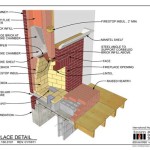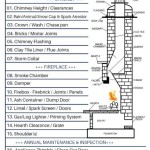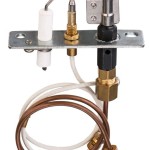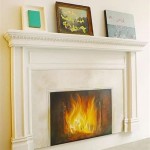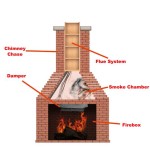Gas Fireplace Heat Deflector: Protecting Your TV
Gas fireplaces offer a convenient and aesthetically pleasing way to add warmth and ambiance to a living space. However, the concentrated heat they produce can pose a risk to electronic devices, particularly televisions, mounted above or near the fireplace. Excessive heat exposure can damage a television's internal components, leading to reduced performance, a shortened lifespan, or complete failure. A gas fireplace heat deflector is designed to mitigate this risk by redirecting heat away from the television, thereby protecting it from potentially damaging temperatures. This article explores the function, types, installation, and considerations involved in choosing and using a gas fireplace heat deflector to safeguard a television.
Understanding the Need for a Heat Deflector
The primary reason for using a gas fireplace heat deflector is to protect a television from the direct and radiant heat emitted by the fireplace. Unlike traditional wood-burning fireplaces which release a significant amount of heat up the chimney, gas fireplaces often radiate a substantial amount of heat forward and upward into the room. This upward heat flow can directly impact any object mounted above the fireplace, including a television. The heat generated can cause various problems, ranging from minor cosmetic issues to significant functional damage.
Excessive heat can warp the plastic casing of the television, discolor the screen, and, most critically, impact the delicate internal electronics. LCD and LED screens are particularly susceptible to heat damage. Prolonged exposure to high temperatures can cause pixel degradation, leading to discoloration, dead pixels, or image distortion. The circuit boards and other components within the television can also be affected, resulting in unpredictable behavior, reduced lifespan, and ultimately, failure.
Furthermore, manufacturers typically specify an operating temperature range for their televisions. Exceeding these temperature limits voids the warranty in many cases. Therefore, using a heat deflector is not just about preventing immediate damage; it is also about preserving the television's functionality and maintaining its warranty coverage over the long term.
The effectiveness of a heat deflector is dependent on several factors, including the size and BTU output of the fireplace, the distance between the fireplace and the television, and the type of deflector used. Therefore, careful consideration of these factors is crucial in selecting and installing an appropriate heat deflector.
Types of Gas Fireplace Heat Deflectors
Gas fireplace heat deflectors are available in various designs, materials, and configurations, each offering different levels of heat protection and aesthetic integration. The choice of a specific type of deflector depends on the fireplace model, the television's proximity, and the desired appearance. The following are some of the common types of heat deflectors available:
Fixed Heat Deflectors: These are permanently mounted deflectors, typically made of metal, that are designed to redirect heat upward and away from the television. They are often integrated into the fireplace surround or mantel during installation. Fixed deflectors offer a consistent level of heat protection but may not be adjustable to accommodate varying heat output or viewing preferences.
Adjustable Heat Deflectors: These deflectors offer a degree of flexibility in terms of angle and position. They can be adjusted to fine-tune the direction of heat flow, allowing for optimal protection based on the specific circumstances. Adjustable deflectors are particularly useful for fireplaces with variable heat settings or for situations where the television is mounted close to the fireplace.
Magnetic Heat Deflectors: These deflectors utilize magnets to attach to the metal surfaces of the fireplace. They are relatively easy to install and remove, making them a convenient option for temporary or seasonal use. However, the effectiveness of magnetic deflectors depends on the strength of the magnets and the availability of suitable metal surfaces on the fireplace.
Custom-Built Heat Deflectors: For unique fireplace designs or specific aesthetic requirements, custom-built heat deflectors may be the best option. These deflectors are designed and fabricated to precisely fit the fireplace and address the specific heat-related challenges. Custom deflectors offer the greatest degree of control over heat redirection and aesthetic integration, but they are typically more expensive than off-the-shelf options.
The material used in the construction of the heat deflector also plays a crucial role in its performance. Metal deflectors, particularly those made of steel or aluminum, are effective at conducting and dissipating heat. However, it’s important that the material doesn’t become excessively hot itself, potentially radiating heat towards the television. Some deflectors incorporate insulation or heat-resistant coatings to reduce their surface temperature.
Installation and Key Considerations
The installation process for a gas fireplace heat deflector varies depending on the type of deflector and the specific fireplace model. Generally, fixed deflectors are installed during the fireplace installation process, while adjustable and magnetic deflectors can be installed after the fact. Regardless of the type of deflector, it is crucial to follow the manufacturer's instructions carefully to ensure proper installation and effective heat protection. Several key considerations are essential for successful installation and optimal performance:
Measurement and Compatibility: Before purchasing a heat deflector, it is important to accurately measure the dimensions of the fireplace opening and the available space above the fireplace. Ensure that the deflector is appropriately sized for the fireplace and that it does not obstruct the fireplace's ventilation or other critical functions. The deflector must also be compatible with the fireplace's design and construction materials.
Clearance and Ventilation: Maintain adequate clearance between the heat deflector and the television. The deflector should be positioned in such a way that it effectively redirects heat away from the television without trapping heat within the surrounding area. Ensure that there is sufficient ventilation around the television to allow for proper heat dissipation. Avoid blocking any ventilation ports on the television.
Material Selection: Choose a heat deflector made of heat-resistant materials that can withstand the high temperatures generated by the fireplace. Metal deflectors are generally effective, but ensure that they are properly coated or insulated to prevent excessive surface heating. The material should also be durable and resistant to corrosion, ensuring long-term performance.
Aesthetics and Integration: The heat deflector should blend seamlessly with the fireplace and the surrounding décor. Consider the color, finish, and design of the deflector to ensure that it complements the overall aesthetic of the room. Opt for a deflector that is unobtrusive and does not detract from the visual appeal of the fireplace.
Testing and Monitoring: After installing the heat deflector, it is important to test its effectiveness by monitoring the temperature of the television during fireplace operation. Use a thermometer or infrared temperature sensor to measure the surface temperature of the television screen and casing. Ensure that the temperature remains within the manufacturer's recommended operating range. If the temperature exceeds the recommended range, adjust the deflector's position or consider using a different type of deflector.
Professional Installation: If uncertain about the installation process, consider hiring a qualified professional to install the heat deflector. A professional can ensure that the deflector is properly installed and that it effectively protects the television from heat damage. Professional installation may also be required to maintain the validity of the fireplace's warranty.
Regular Maintenance: Periodically inspect the heat deflector for signs of damage or wear. Clean the deflector regularly to remove dust and debris that can accumulate and reduce its effectiveness. Replace the deflector if it becomes damaged or deteriorated.
In addition to a heat deflector, other measures can be taken to further protect a television mounted above a gas fireplace. These include increasing the distance between the fireplace and the television, using a mantel to provide additional shielding, and installing a temperature sensor that automatically shuts off the fireplace if the temperature exceeds a safe limit.
Evaluating Temperature and Alternative Solutions
Determining whether a heat deflector is truly necessary involves carefully evaluating the temperature around the television during fireplace use. Simply feeling the air is not sufficient; precise temperature measurements are crucial. An infrared thermometer can be used to measure the surface temperature of the television at various points while the fireplace is operating at its highest setting for a sustained period (e.g., one hour). These readings should be compared against the television manufacturer's specified maximum operating temperature. If the television's surface temperature consistently exceeds this limit, a heat deflector is likely essential.
Beyond heat deflectors, several alternative or supplementary solutions can further mitigate the risk of heat damage. Consider the following:
Increased Mounting Distance: The further the television is mounted from the fireplace, the less heat it will be exposed to. If possible, increase the vertical distance between the top of the fireplace insert and the bottom of the television. Even a few extra inches can make a significant difference in temperature reduction.
Mantel Installation: A substantial mantel acts as a physical barrier, deflecting heat away from the television. A deeper mantel will provide more effective protection. When choosing a mantel, ensure it is made of a non-combustible material like stone or concrete. If a wooden mantel is desired, ensure it is treated with a fire-retardant coating.
Temperature Sensors and Automatic Shut-Offs: Install a temperature sensor near the television that monitors the ambient temperature. Set a temperature threshold that, when exceeded, triggers an automatic shut-off of the fireplace. These devices provide an added layer of protection, preventing the television from overheating even if the heat deflector fails to perform adequately.
Adjustable Fireplace Settings: Use the fireplace's adjustable flame height or heat output settings. Lowering the flame or reducing the heat output will decrease the amount of heat radiating upwards towards the television. While this may reduce the aesthetic appeal, it can significantly prolong the television's lifespan.
Regular Temperature Monitoring: Regardless of the chosen heat mitigation strategy, consistently monitor the temperature around the television during fireplace use. This ongoing monitoring allows for early detection of potential overheating issues and enables adjustments to be made as needed. Keep a log of temperature readings over time to track trends and identify patterns.
Protecting a television from the heat generated by a gas fireplace requires a proactive and informed approach. By understanding the risks, selecting an appropriate heat deflector, and implementing supplementary heat mitigation strategies, one can enjoy the warmth and ambiance of a gas fireplace without compromising the longevity and performance of the television.

Best Way To Install Mantle Tv Or Sound Bar Heat Shield

Fireplace Hoods Heat Deflectors Custom

Mantleflect Shield

Top 8 Ways To Keep Your Tv Safe From Fireplace Heat Northern Feeling

Top 8 Ways To Keep Your Tv Safe From Fireplace Heat Northern Feeling

51 Inch Standard Fireplace Hood 24 Gauge Steel

Installing A Tv Above Your Fireplace Lopi Fireplaces

Installing A Tv Above Your Fireplace Lopi Fireplaces

Installing A Tv Above Your Fireplace Lopi Fireplaces

How Can I Prevent The Mantel Above A Gas Fireplace From Getting Hot Home Improvement Stack Exchange


